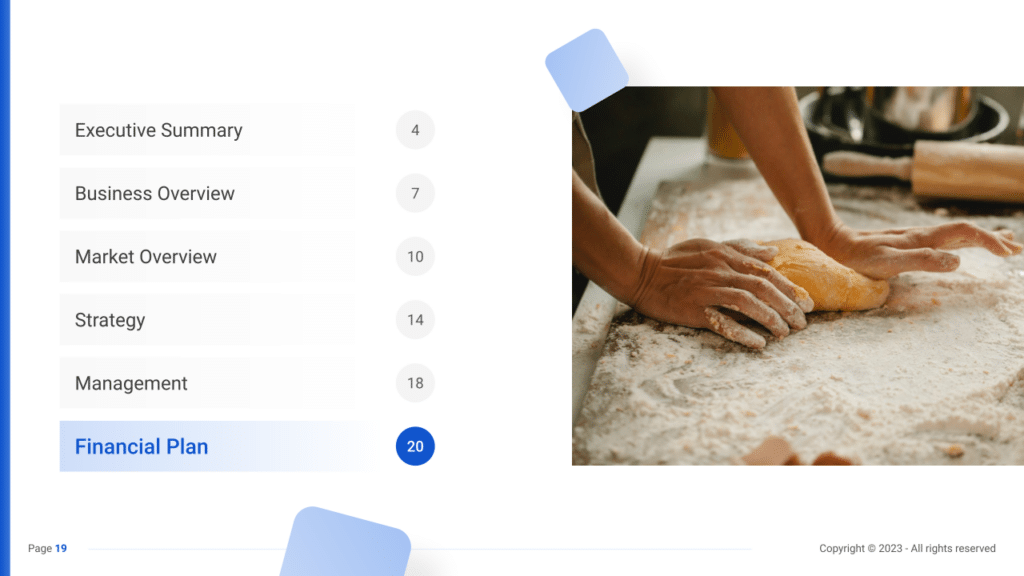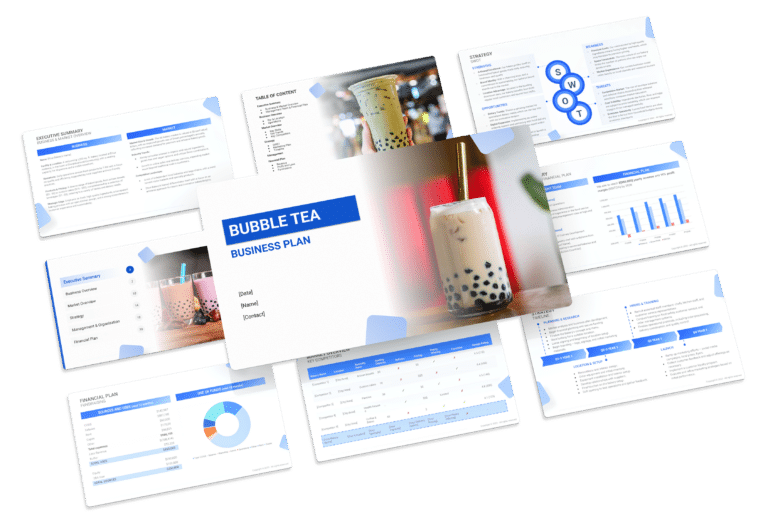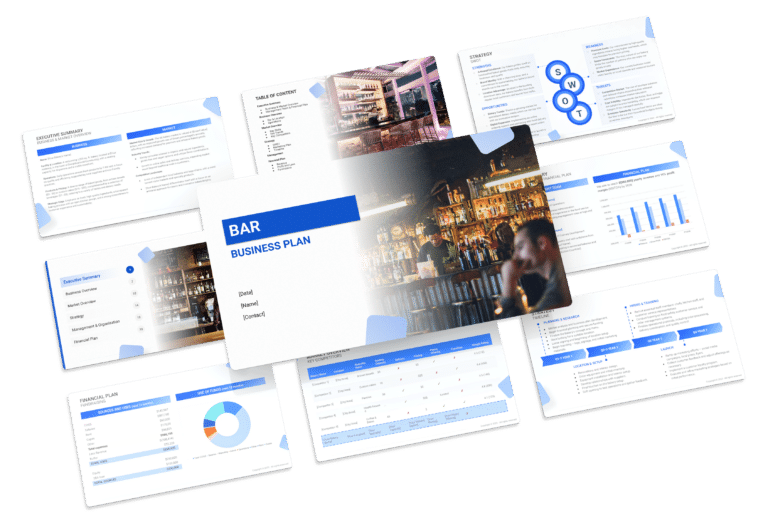Bakery Business Plan PDF Example
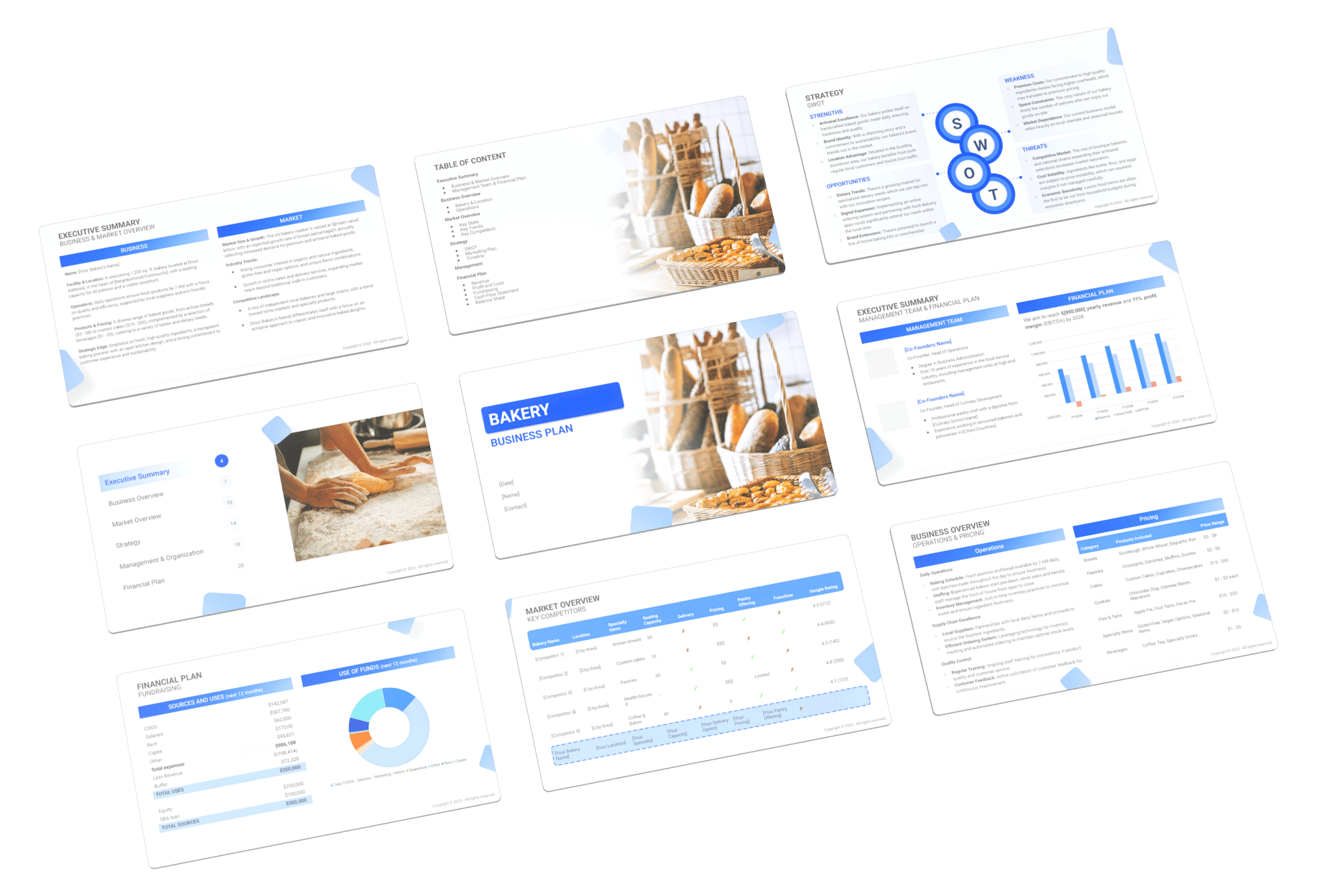
Creating a comprehensive business plan is crucial for launching and running a successful bakery. This plan serves as your roadmap, detailing your vision, operational strategies, and financial plan. It helps establish your therapy bakery’s identity, navigate the competitive market, and secure funding for growth.
This article not only breaks down the critical components of a bakery business plan, but also provides an example of a business plan to help you craft your own.
Whether you’re an experienced entrepreneur or new to the food&beverage industry, this guide, complete with a business plan example, lays the groundwork for turning your bakery concept into reality. Let’s dive in!
The Plan
Our bakery business plan is designed to encompass all crucial elements required for a thorough strategic approach. It details the bakery’s operations, marketing strategy, market environment, competitors, management team, and financial projections, ensuring a holistic view of the business’s path to success.
- Executive Summary: Offers an overview of your bakery’s business idea, market research, management team, and financial plans.
- Business Overview: Details what your bakery offers and how it operates:
- Bakery & Location: Describes your bakery’s layout, features, and why its location is perfect for customers.
- Operations: Outlines daily bakery operations, including baking schedules, staffing, and ingredient sourcing.
- Market Overview: Looks at the bakery market, finding competitors and what makes your bakery unique:
- Key Stats: Provides figures on the size and growth of the bakery market.
- Key Trends: Points out new trends in the bakery industry, such as the rise in health-conscious and specialty products.
- Key Competitors: Discusses major nearby bakeries and how your bakery offers something different.
- Strategy: Describes your plan for growing the bakery and attracting customers:
- SWOT: Analyzes strengths, weaknesses, opportunities, and threats related to your bakery.
- Marketing Plan: Outlines methods for promoting your bakery and keeping customers coming back.
- Timeline: Lists important goals and milestones from the beginning through the first year.
- Management: Shares info on who runs the bakery and their responsibilities.
- Financial Plan: Forecasts the bakery’s financial outlook over 5 years, including income, profit margins, and main expenses.

Executive Summary
The Executive Summary introduces your bakery’s business plan, offering a concise overview of your bakery and its offerings. It should detail your market positioning, the range of baked goods and confectionery items you offer, its location, size, and an outline of day-to-day operations.
This section should also explore how your bakery will integrate into the local market, including the number of direct competitors within the area, identifying who they are, along with your bakery’s unique selling points that differentiate it from these competitors. These could include special dietary options like gluten-free or vegan products, artisanal or locally sourced ingredients, or a particular specialty in certain types of baked goods.
Furthermore, you should include information about the management and co-founding team, detailing their roles and contributions to the bakery’s success. This could involve their culinary expertise, business management experience, or community relations. Additionally, a summary of your financial projections, including revenue and profits over the next five years, should be presented here to provide a clear picture of your bakery’s financial plan.
Bakery Business Plan Executive Summary Example
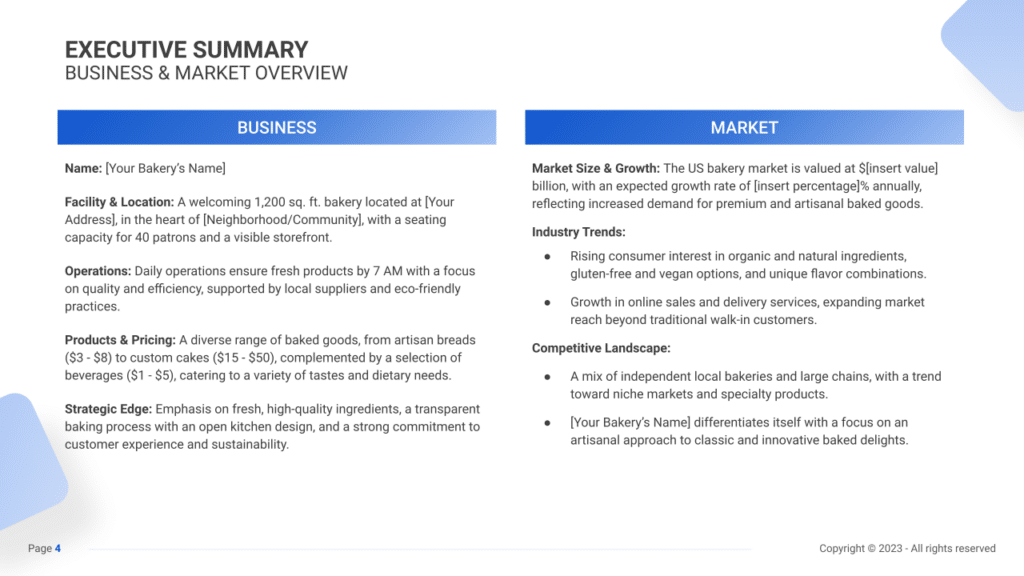
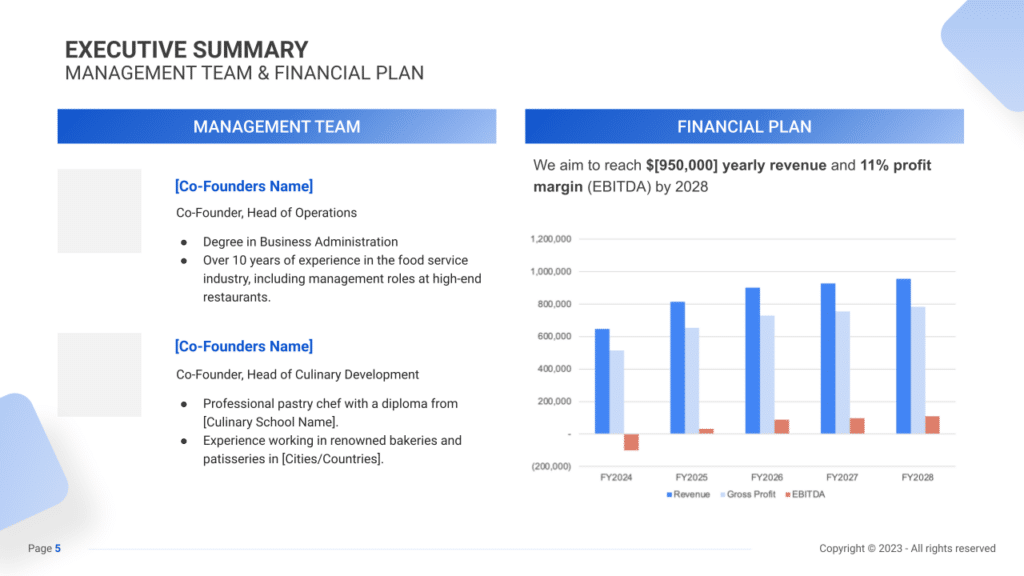
Business Overview
When detailing the business overview in your executive summary, it’s crucial to provide clear and concise information. This includes the name of your bakery, its location, and an overview of daily operations.
These details not only introduce your business but also set the stage for its unique qualities. Indeed, a unique selling proposition (USP) is what sets your bakery apart from the competition. Whether it’s your focus on artisanal techniques, your range of gluten-free options, or your commitment to sustainability, your USP should be a focal point of your executive summary. It’s what captures the interest of your audience and showcases the unique value your business brings to the market.
Example:
For instance, “Sweet Temptations Bakery,” located in downtown Springfield, operates from a 1,500 sq. ft. space on Main Street. It opens early at 6 AM, serving a range of traditional and health-conscious baked goods. Their USP is the unique combination of classic baking styles with modern trends, offering gluten-free and vegan options alongside traditional pastries.
Market Overview
Understanding and presenting the market size, growth trends, and industry dynamics are integral parts of the market analysis.
This section should highlight the potential of the U.S. bakery market, backed by relevant data like market value and growth rates. Discussing industry trends, such as the rising demand for organic ingredients or innovative baking techniques, provides insight into the evolving landscape and where your bakery fits within it.
Equally important is the competitive landscape. Your executive summary should identify key competitors and explain how your bakery positions itself in this environment. Whether you focus on niche products, exceptional customer service, or unique flavor combinations, this is your opportunity to showcase how your bakery is poised to stand out in a crowded market.
Example:
Consider Sweet Temptations Bakery in the U.S. bakery market, valued at $30 billion with a 5% annual growth rate. While competing with local bakeries and national chains in Springfield, Sweet Temptations differentiates itself by offering products like avocado-chocolate muffins and quinoa bread, catering to health-conscious consumers.
Management Team
The management team’s background and expertise are significant assets to your business. In your executive summary, highlight the key qualifications and experiences of your team members.
This might include your co-founder’s decade of experience in food service management or your head baker’s formal culinary training. Demonstrating the team’s expertise not only builds credibility but also assures potential investors and partners of your bakery’s capability to succeed.
Example:
At Sweet Temptations, co-founders Jane Doe and John Smith lead the team. Jane, an MBA graduate, has 15 years of experience in the hospitality industry, while John, a culinary school graduate, brings his expertise from working in renowned European bakeries, adding substantial value to the bakery’s management and product innovation.
Financial Plan
The financial plan overview should succinctly summarize your financial goals and projections, including revenue targets and profit margins, to provide a clear picture of your bakery’s financial trajectory.
Example:
Sweet Temptations aims for $500,000 in annual revenue by year three, targeting a 12% EBITDA margin. The financial strategy includes an initial investment in high-quality baking equipment and a welcoming shop atmosphere, with sales growth driven by effective marketing and community involvement, positioning the bakery for profitability and local acclaim within five years.
Business Overview
For a Bakery, the Business Overview section can be concisely divided into 2 main slides:
Bakery & Location
Briefly describe the bakery’s physical environment, emphasizing its design, warmth, and the inviting atmosphere that welcomes customers. Mention the bakery’s location, highlighting its accessibility and the convenience it offers to customers, such as proximity to community centers, schools, or ease of parking.
Explain why this location is advantageous in attracting your target clientele, which might include local residents, businesses looking for catering options, or foot traffic from nearby shopping areas.
Operations
Detail the range of baked goods and products offered, from bread and pastries to custom cakes and specialty items. Outline your operational strategy, including sourcing of ingredients, baking schedules to ensure freshness, and any unique services such as custom orders or catering.
Discuss your pricing strategy, ensuring it reflects the quality of ingredients and craftsmanship involved and matches the market you’re targeting. Highlight any special offerings, loyalty programs, or community events that provide added value to your customers, encouraging repeat visits and customer loyalty.
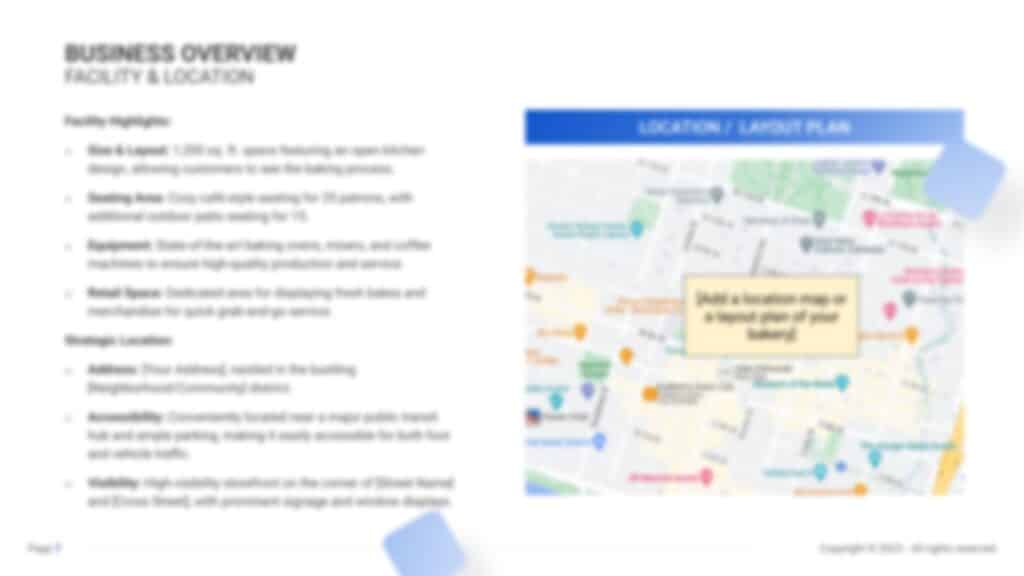
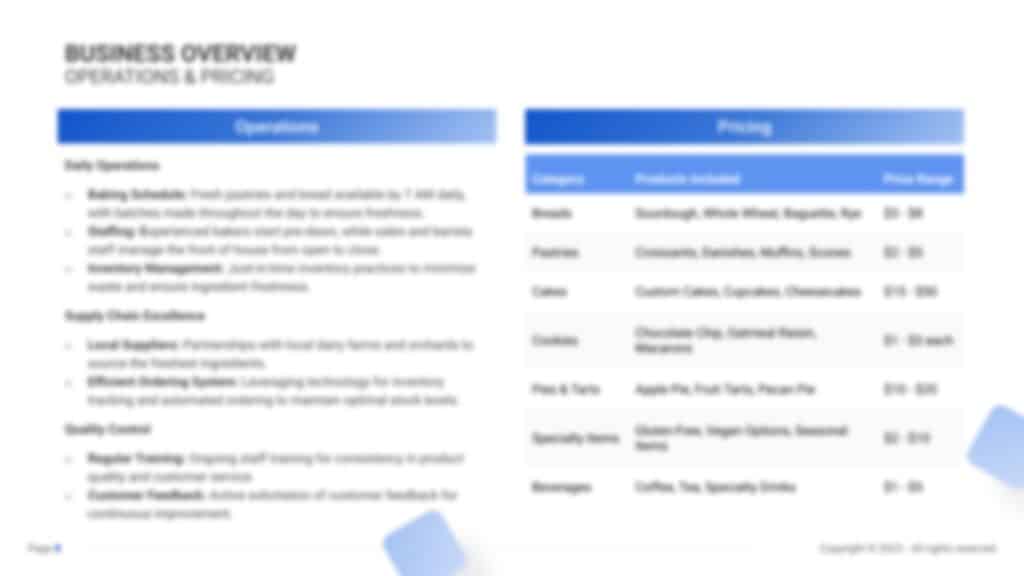
Market Overview
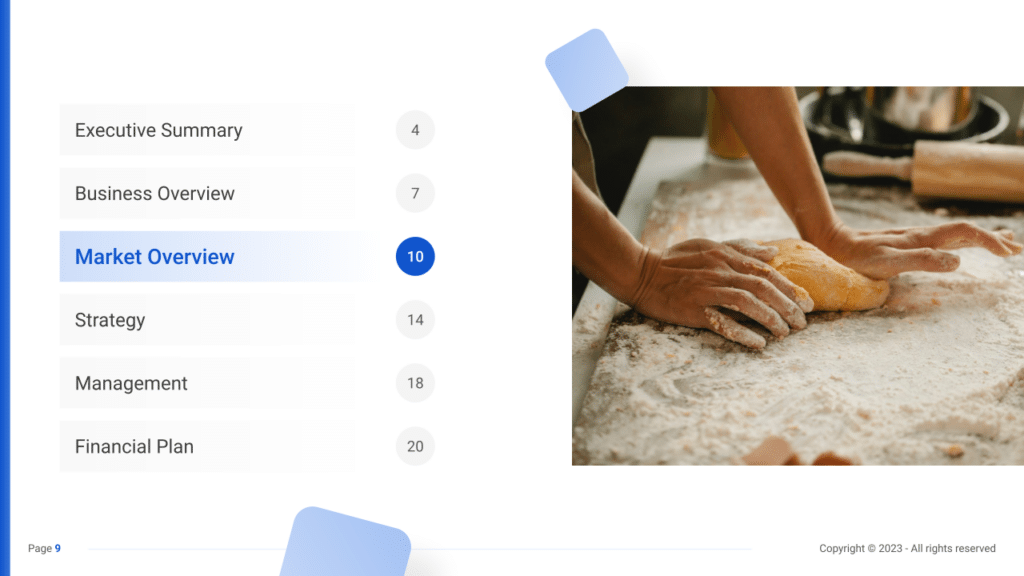
Industry size & growth
In the Market Overview of your bakery business plan, begin by assessing the size of the bakery industry and its potential for growth. This evaluation is essential for grasping the market’s extent and pinpointing opportunities for expansion.
Analyze factors such as the increasing demand for baked goods, both traditional and innovative, and how consumer preferences are shaping the industry.
Key market trends
Continue by discussing recent market trends that are influencing consumer behavior and preferences in the bakery sector. This might include a growing interest in artisanal and craft baked products, the surge in popularity of gluten-free and vegan options, and the integration of international flavors and ingredients into traditional bakery products.
Highlight the demand for high-quality, fresh, and specialty baked goods that cater to diverse dietary needs and cultural tastes, as well as the trend towards more health-conscious and sustainable baking practices.
Key competitors
A competitive analysis is not just a tool for gauging the position of your bakery in the market and its key competitors; it’s also a fundamental component of your business plan.
This analysis helps in identifying your bakery’s unique selling points, essential for differentiating your business in a competitive market.
In addition, the competitive analysis is integral in laying a solid foundation for your business plan. By examining various operational aspects of your competitors, you gain valuable information that ensures your business plan is robust, informed, and tailored to succeed in the current market environment.
Identifying Your Competitors in the Bakery Industry
Identifying competitors is the first step in understanding your position in the bakery market. Begin by mapping out local bakeries and pastry shops. For instance, if your bakery specializes in artisan bread, your direct competitors include nearby bakeries known for their bread, as well as larger grocery stores with in-house bakeries. Don’t overlook indirect competitors such as cafes or dessert shops that offer a range of baked goods.
Use online tools like Google Maps to get a geographical sense of competitor distribution. Platforms like Yelp and TripAdvisor offer customer reviews and ratings, providing insights into competitors’ strengths and weaknesses. For example, if several reviews commend the cozy ambiance and fresh pastries at “Sweet Treats Bakery,” this is a key strength of your competitor.

Bakery Competitors’ Strategies
Analyzing the strategies of these competitors involves several aspects:
- Baked Goods Offerings: Examine their range of baked goods. If “Healthy Bakes” down the street is gaining popularity with its gluten-free and vegan options, it indicates a market trend towards health-conscious baking.
- Baking Techniques: Consider the baking techniques and styles. A bakery like “Old World Breads” that focuses on traditional, handcrafted bread might appeal to a different customer base than one like “Modern Bakes,” known for innovative and trendy pastry creations.
- Pricing Strategy: Compare your prices with those of competitors. Are your baked goods priced similarly to “Budget Bites Bakery” or are they more aligned with the premium offerings at “Gourmet Pastries”?
- Marketing Tactics: Look at how competitors market their products. Do they have a strong social media presence, or do they rely more on local community engagement and word-of-mouth?
- Customer Experience: Assess the in-store experience. For instance, “Cozy Corner Bakery” might be known for its inviting atmosphere and friendly staff, enhancing the customer experience.
- Operational Efficiency: Observe if competitors are using technology or innovative processes to streamline baking and serving, such as “Efficient Eats” with its online ordering system.
What’s Your Bakery’s Value Proposition?
Reflect on your bakery’s unique value proposition. Maybe your bakery is known for its signature sourdough bread, or perhaps you offer a unique range of international pastries that aren’t available elsewhere in your area.
Identify market gaps through customer feedback and industry trends. For example, the growing interest in artisan and locally sourced ingredients could represent a market opportunity if competitors are not addressing this demand.
Consider your location: A bakery in a busy downtown area might focus on quick service and grab-and-go items, while a bakery in a residential neighborhood could capitalize on a more relaxed, community-oriented atmosphere.
Strategy
SWOT
First, conduct a SWOT analysis for the bakery, highlighting Strengths (such as artisanal baking skills and a unique range of products), Weaknesses (including potentially high ingredient costs or stiff competition), Opportunities (for example, a growing interest in specialty and health-conscious baked goods), and Threats (such as fluctuations in raw material prices or changes in consumer spending due to economic conditions).

Marketing Plan
Next, formulate a marketing plan that details strategies for attracting and retaining customers through targeted advertising, seasonal promotions, a compelling social media presence, and engagement with the local community. Consider loyalty programs, baking workshops, and collaborations with local businesses as part of your promotional activities.
Marketing Channels
Explore diverse marketing channels to connect with your audience and promote your bakery:
Digital Marketing
- Website and Online Presence: Your bakery’s website should be more than just an online menu. It should be a reflection of your brand story and values. Incorporate high-quality images of your delectable baked goods, customer testimonials, and an easy-to-navigate layout. Implement an online ordering system for pickups or deliveries to enhance convenience for customers.
- Social Media Engagement: Utilize platforms like Instagram, Facebook, and Pinterest to share high-quality images of your baked goods, and behind-the-scenes content, and interact with customers. Engage with your audience by responding to comments and messages promptly.
Local Advertising
- Flyers and Local Partnerships: Distribute well-designed flyers and brochures not only in high-traffic areas but also in locations aligned with your target audience’s interests, such as fitness centers, coffee shops, or local events. Collaborate with nearby businesses for cross-promotions or joint marketing efforts, allowing you to tap into each other’s customer bases.
- Community Engagement: Participate in local events, farmers’ markets, or charity bake sales to increase visibility and connect with the community. Sponsor or host baking workshops or educational sessions to engage with potential customers.
Promotional Activities
- Seasonal Offers: Launch special promotions tied to seasons or holidays, such as ‘Holiday Cookie Gift Boxes’ or ‘Spring Cupcake Flavors’. Create limited-time offers that create a sense of urgency and exclusivity.
- Loyalty Programs: Loyalty programs are effective tools for fostering customer loyalty. Implement a tiered rewards system or a punch card where customers earn points for each purchase, redeemable for discounts or free items. Personalize rewards based on customer preferences to enhance engagement.

Sales Channels
Optimize sales channels to boost revenue and customer satisfaction:
In-Store Upselling
- Value-Added Services: Train your staff to recommend add-ons like specialty spreads for bread, custom cake decorations, or exclusive dessert pairings during customer visits. Offer tastings or samples to encourage additional purchases.
- Product Displays: Enhance the in-store experience by designing product displays that are visually appealing and informative. Incorporate storytelling elements to highlight the ingredients or craftsmanship behind your baked goods. This approach not only drives sales but also educates customers about your products.
Online Sales and Services
- E-commerce Integration: Set up an intuitive and secure online ordering system for specialty items, customized cakes, or pre-packaged baked goods for pickup or delivery. Ensure a seamless checkout process to reduce cart abandonment.
- Virtual Consultations: Offer online consultations for customized cake designs or event catering. Provide options for virtual tastings or meetings to discuss personalized requirements, ensuring a personalized and convenient experience.
Membership and Rewards
Encourage repeat business and foster customer loyalty:
- Subscription Models: Develop subscription-based models offering regular deliveries of baked goods or exclusive access to new products. Create tiers with varying benefits to cater to different customer preferences.
- Reward Programs: Institute a digital loyalty system rewarding customers with points for purchases redeemable for discounts or complimentary items. Send personalized offers based on customers’ purchase behavior to enhance engagement.
Timeline
Finally, establish a detailed timeline that marks key milestones for the bakery’s launch, marketing initiatives, customer base development, and potential expansion goals. This timeline should guide the business towards achieving its objectives with precision and clarity, ensuring systematic progress in a competitive market.

Management
The Management section focuses on the bakery’s management and their direct roles in daily operations and strategic direction. This part is crucial for understanding who is responsible for making key decisions and driving the bakery towards its financial and operational goals.
For your bakery business plan, list the core team members, their specific responsibilities, and how their expertise supports the business.
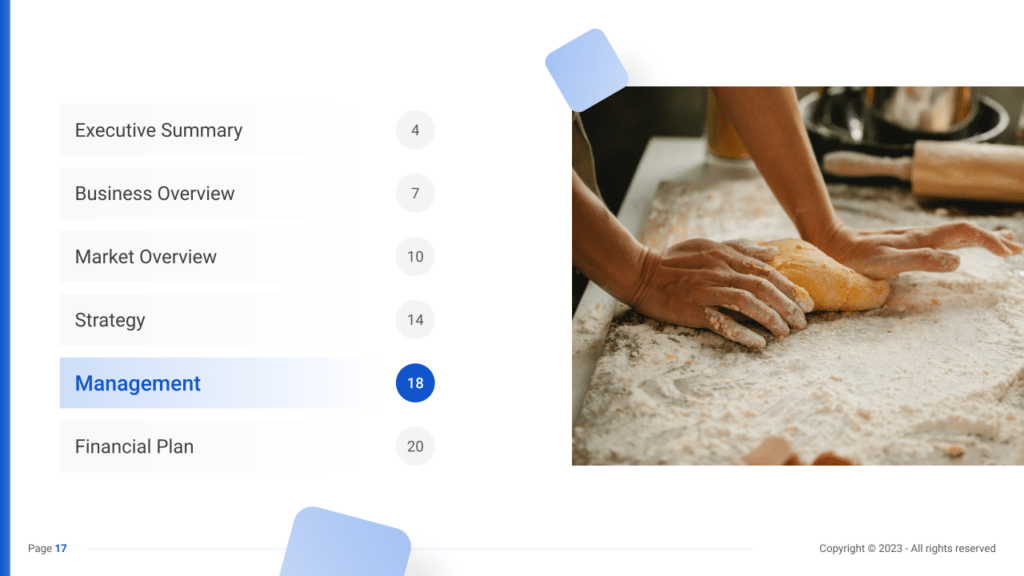

Financial Plan
The Financial Plan section is a comprehensive analysis of your financial projections for revenue, expenses, and profitability. It lays out your bakery’s approach to securing funding, managing cash flow, and achieving breakeven.
This section typically includes detailed forecasts for the first 5 years of operation, highlighting expected revenue, operating costs and capital expenditures.
For your bakery business plan, provide a snapshot of your financial statement (profit and loss, balance sheet, cash flow statement), as well as your key assumptions (e.g. number of customers and prices, expenses, etc.).
Make sure to cover here
_ Profit and Loss
_ Cash Flow Statement
_ Balance Sheet
_ Use of Funds
